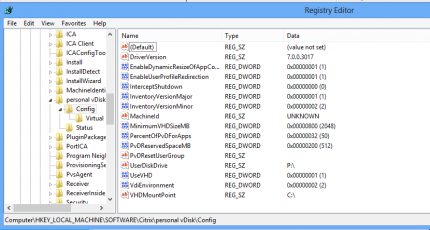Citrix Personal vDisk, a registry key break down
![]() While preparing for the 1Y1-200 and 1Y1-300 exams based on the Exam Preparation Guides released by Citrix I realized that my knowledge of the Personal vDisk was a little bit rusty as I don’t use Personal vDisk (PvD) that often.
While preparing for the 1Y1-200 and 1Y1-300 exams based on the Exam Preparation Guides released by Citrix I realized that my knowledge of the Personal vDisk was a little bit rusty as I don’t use Personal vDisk (PvD) that often.
After reading the eDocs I noticed that not all possible registry keys were mentioned so I wanted to do a break down on the registry keys for the Citrix Personal vDisk.
Personal vDisks provide separation of data en personalized settings by redirecting changes made on the user’s VM to a separate disk. The PvD is blended to the VM so the user won’t notice the addition of the PvD and thus delivering the same experience as on an oldschool fat client. From the eDocs on Personal vDisks in XenDesktop 7:
Personal vDisks have two parts, which are by default equally sized:
- One part comprises C:\Users (in Windows 7) or C:\Documents and Settings (in Windows XP). This contains user data, documents, and the user profile. By default this uses drive P: but you can choose a different drive letter when you use Studio to create a machine catalog with Personal vDisks.
- The other part comprises a Virtual Hard Disk file (a .vhd file). This contains all other items, for example applications installed in C:\Program Files. This part is hidden from users; it is not displayed in Windows Explorer.
Personal vDisks support the provisioning of department-level applications, as well as applications downloaded and installed by users, including those that require drivers, databases, and PC management software. If a user’s change conflicts with an administrator’s change, a Personal vDisk provides a simple and automatic way to reconcile the changes.
When searching on information about the PvD registry keys I came across this screenshot from, apparently, an older version of PvD:

Moving forward I found the following keys in the different eDocs and knowledge base articles.
Key : HKEY_LOCAL_MACHINE\Software\Citrix\personal vDisk\Config
| AutoActivate | REG_DWORD | Enables the automatic activation of the PvD |
| BlockLogonIfUpdateInProgres | REG_DWORD | Blocks logon while an update to the vDisk is in progress when set to 1 |
| EnableUserProfileRedirection | REG_DWORD | This value ensures that all of the space on P: is allocated to applications |
| HideVHDMountPoint | REG_DWORD | This hides the VDIMountPoint from the explorer view |
| InterceptShutdown | REG_DWORD | Educated guess: This value is for the inventory reminder when updating a PvD inventory and you’re shutting down the VM |
| MachineId | REG_SZ | The machine ID (hostname) |
| PercentOfPvDForApps | REG_DWORD | This sets the default allocation of space on the personal vDisk |
| PowerOffAfterUpdate | REG_DWORD | Educated guess: This will power off the machien after an update of the inventory |
| PvDResetUserGroup | REG_SZ | To enable other users to reset personal vDisks, add these users to an Active Directory security group, then add this security group to the PvDResetUserGroup registry key on the desktop machine. |
| UserDiskDrive | REG_SZ | This sets the drive for the PvD |
| VdiEnvironment | REG_DWORD | Determines if the device is part of a VDI environment |
| VHDMountPoint | REG_SZ | This value sets the VHD Mount point |
I found a couple of the reg keys just from the documentation but it got me wondering if they documented everything. So with the great help from Andrew Morgan who opened up his lab for me I got a Windows 8 desktop with PvD up and running within minutes and took the following screenshot:
In this newer version of PvD (7.x) there are a couple more registry keys available:
| MinimumVHDSizeMB | REG_DWORD | To set the desired new initial size of the VHD (in megabytes |
| PvDReservedSpaceMB | REG_DWORD | To Set the size of reserved space in MD for PvD |
| EnableDynamicResizeOfAppContainer | REG_DWORD | This value enabled/disables dynamic resizing algorithm |
| InventoryVersionMinor | REG_DWORD | User defined minor release number |
| InventoryVersionMajor | REG_DWORD | User defined major release number |
I hope this article helps you understand the available keys in the Citrix Personal vDisk. If you have an addition to this list please leave a comment, I would also love to hear about your thoughts about the educated guesses I did on the registry keys that were missing in the documentation.
Kees Baggerman
Latest posts by Kees Baggerman (see all)
- Nutanix AHV and Citrix MCS: Adding a persistent disk via Powershell – v2 - November 19, 2019
- Recovering a Protection Domain snapshot to a VM - September 13, 2019
- Checking power settings on VMs using powershell - September 11, 2019
- Updated: VM Reporting Script for Nutanix with Powershell - July 3, 2019
- Updated (again!): VM Reporting Script for Nutanix AHV/vSphere with Powershell - June 17, 2019

3 comments